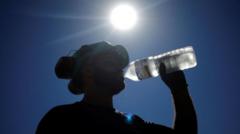The World Health Organization (WHO) has issued a pressing warning that the ongoing climate crisis is intensifying workplace heat stress, particularly affecting construction and agricultural laborers. The latest findings, in collaboration with the World Meteorological Organization, underscore the growing health threats posed by increasingly frequent heatwaves as temperatures continue to rise globally.
This alarming report reveals that millions of workers are currently exposed to extreme heat, with potentially severe consequences for both their health and productivity. Rüdiger Krech, WHO's director of environment, climate and health, emphasized that the risks of extreme heat extend beyond mere discomfort, potentially leading to life-threatening conditions such as heatstroke and kidney failure. With 2024 projected to become the hottest year recorded, this analysis serves as an urgent wake-up call for stakeholders across various sectors.
Data indicates that for every degree Celsius increase in temperature beyond 20°C, labor productivity decreases by approximately 2%. Additionally, workplace accidents are alarmingly on the rise; a recent assessment during Europe's heatwave revealed that accidents surged by 7% whenever temperatures exceeded 30°C. In response to these challenges, Western European nations like Italy and Switzerland are beginning to implement urgent measures aimed at enhancing worker safety during extreme heat events.
Italy has already taken steps toward protecting its workforce by enacting a decree that prevents outdoor work during the hottest parts of the day. In Switzerland, construction work was temporarily halted during the recent heatwave, a decision welcomed by trade unions advocating for workers' health. The unions insist that it is crucial for employers to recognize unacceptable working conditions due to extreme heat.
The WHO report not only focuses on workplace environments, but also identifies vulnerable populations such as the elderly, children, and those with chronic illnesses. As heatwaves become more common, the need for adaptive measures extends beyond workplaces to schools and other public institutions. For instance, Germany has protocols in place to temporarily suspend classes during extreme heat, although these practices are increasingly challenged by the frequency of high temperatures.
Krech pointed out that reassessing school uniforms to better suit warmer climates is among many considerations needed. While redesigning school buildings with ventilation and cooling systems is essential, it requires significant financial investment, which is becoming more challenging as governments prioritizing military expenses may overlook climate change adaptations.
Ultimately, Krech warns that failing to invest in protective measures against heat stress could result in greater long-term costs due to declining productivity and adverse health outcomes. As these adjustments are deemed necessary for a productive and healthy working environment, cooperation among governments, employers, and local authorities becomes paramount. Addressing the crises posed by the evolving climate, the WHO advocates for timely and comprehensive action that secures the health of workers and society as a whole.




















